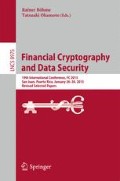Abstract
We present a novel approach to user authentication in which biometric data related to human cognitive processes, in particular visual search, working memory and priming effect on automatic processing, are captured and used to identify users. Our proposed system uses a carefully designed Cognitive Task (CT) that is presented to the user as a game, in order to capture a “cognitive signature” of the user. Our empirical results support the hypothesis that the captured cognitive signatures can identify users across different platforms. Our system provides a proof-of-concept for cognitive-based biometric authentication. We validate the robustness of our system against impersonation attack by experienced users, and show that it is hard to reproduce the cognitive signature by mimicking users’ gameplay.
Access this chapter
Tax calculation will be finalised at checkout
Purchases are for personal use only
References
Galotti, K.M.: Cognitive Psychology In and Out of the Laboratory. SAGE Publications Inc., Thousand Oaks (2013)
Sternberg, R.J.: Cognitive Psychology. Cengage Learning (2011)
Amazon mechanical turk. https://www.mturk.com/mturk/welcome. Accessed on 12/12/2014
Gamboa, H., Fred, A.: A behavioral biometric system based on human-computer interaction. Proc. SPIE 5404, 381–392 (2004)
Ahmed, A., Traore, I.: A new biometric technology based on mouse dynamics. IEEE Trans. Dependable Secure Comput. 4(3), 165–179 (2007)
Zheng, N., Paloski, A., Wang, H.: An efficient user verification system via mouse movements. In: Proceedings of the 18th ACM Conference on Computer and Communications Security CCS 2011, pp. 139–150. ACM, New York (2011)
Frank, M., Biedert, R., Ma, E., Martinovic, I., Song, D.: Touchalytics: on the applicability of touchscreen input as a behavioral biometric for continuous authentication. IEEE Trans. Inf. Forensics Secur. 8(1), 136–148 (2013)
Wickens, C.D., Lee, J.D., Liu, Y., Gordon-Becker, S.: Introduction to Human Factors Engineering, 2nd edn. Pearson, Upper Saddle River (2003)
Van Zandt, T., Townsend, J.T.: Self-terminating versus exhaustive processes in rapid visual and memory search: an evaluative review. Percept. Psychophys. 53(5), 563–580 (1993)
Bargh, J.A., Chen, M., Burrows, L.: Automaticity of social behavior: direct effects of trait construct and stereotype activation on action. J. Pers. Soc. Psychol. 71(2), 230 (1996)
Sala Della, S., Gray, C., Baddeley, A., Allamano, N., Wilson, L.: Pattern span: a tool for unwelding visuo-spatial memory. Neuropsychologia 37(10), 1189–1199 (1999)
Adams, J.A.: Human Factors Engineering. Macmillan Publishing Co Inc., New York (1989)
Hick, W.E.: On the rate of gain of information. Q. J. Exp. Psychol. 4(1), 11–26 (1952)
Wand, M.P., Jones, M.C.: Kernel Smoothing, vol. 60. CRC Press, Boca Raton (1994)
Zucchini, W., Berzel, A., Nenadic, O.: Applied smoothing techniques (2003)
Rudemo, M.: Empirical choice of histograms and kernel density estimators. Scand. J. Stat. 9, 65–78 (1982)
Bowman, A.W.: An alternative method of cross-validation for the smoothing of density estimates. Biometrika 71(2), 353–360 (1984)
Jones, M.C., Marron, J.S., Sheather, S.J.: A brief survey of bandwidth selection for density estimation. J. Am. Stat. Assoc. 91(433), 401–407 (1996)
Bolle, R.: Guide to Biometrics. Springer, New York (2004)
Brooke, J.: SUS-a quick and dirty usability scale. In: Jordan, J.W., Thomas, B., Weerdmester, B.A., McClelland, I.L. (eds.) Usability Evaluation in Industry, pp. 189–194. Taylor & Francis, London (1996)
Hamdy, O., Traoré, I.: Homogeneous physio-behavioral visual and mouse-based biometric. ACM Trans. Comput. -Hum. Interact. (TOCHI) 18(3), 12 (2011)
Gaines, R.S., Lisowski, W., Press, S.J., Shapiro, N.: Authentication by keystroke timing: Some preliminary results. Technical report, DTIC Document (1980)
Villani, M., Tappert, C., Ngo, G., Simone, J., Fort, H.S., Cha, S.H.: Keystroke biometric recognition studies on long-text input under ideal and application-oriented conditions. In: Conference on Computer Vision and Pattern Recognition Workshop, 2006. CVPRW 2006, pp. 39–39. IEEE (2006)
Kung, S.Y., Mak, M.W., Lin, S.H.: Biometric Authentication: A Machine Learning Approach. Prentice Hall Professional Technical Reference, Upper Saddle River (2005)
Bojinov, H., Sanchez, D., Reber, P., Boneh, D., Lincoln, P.: Neuroscience meets cryptography: designing crypto primitives secure against rubber hose attacks. In: Proceedings of the 21st USENIX Security Symposium (2012)
Lewis, J.R., Sauro, J.: The factor structure of the system usability scale. In: Kurosu, M. (ed.) HCD 2009. LNCS, vol. 5619, pp. 94–103. Springer, Heidelberg (2009)
Chiang, A., Atkinson, R.C.: Individual differences and interrelationships among a select set of cognitive skills. Mem. Cogn. 4(6), 661–672 (1976)
Jensen, A.R.: Individual Differences in the Hick Paradigm. Ablex Publishing, Norwood (1987)
Dovidio, J.F., Gaertner, S.L.: Stereotyping, prejudice, and discrimination: Spontaneous and deliberative processes. Paper presented at the meeting of the Society of Experimental Social Psychology, Washington, DC., October 1995
Acknowledgments
This research is in part supported by Alberta Innovates Technology Futures and Telus Mobility Canada.
Author information
Authors and Affiliations
Corresponding author
Editor information
Editors and Affiliations
A Related Work
A Related Work
The work closest to ours, although it is a combination of mouse dynamics and cognitive factors, is that of Hamdy and Traore [21]. The authors combine visual search and short-term memory effect with mouse dynamics. Their system requires the user to search for letters on a shuffled virtual keyboard. However, it is highly likely that the exposure of the same virtual keyboard and the string of letters have affected the visual search process. The work in [25] uses the concept of implicit learning from cognitive psychology whereby the user is trained on a fixed sequence which can later be used during authentication. Our system does not rely on implicit learning and uses a random challenge sequence and so the user does not repeat the same sequence of activities. Individual differences in visual search task and information processing speed are evident from recent works [27, 28]. Individual differences in automatic processing due to priming are evident from [29].
Rights and permissions
Copyright information
© 2015 Springer-Verlag Berlin Heidelberg
About this paper
Cite this paper
Al Galib, A., Safavi-Naini, R. (2015). User Authentication Using Human Cognitive Abilities. In: Böhme, R., Okamoto, T. (eds) Financial Cryptography and Data Security. FC 2015. Lecture Notes in Computer Science(), vol 8975. Springer, Berlin, Heidelberg. https://doi.org/10.1007/978-3-662-47854-7_16
Download citation
DOI: https://doi.org/10.1007/978-3-662-47854-7_16
Published:
Publisher Name: Springer, Berlin, Heidelberg
Print ISBN: 978-3-662-47853-0
Online ISBN: 978-3-662-47854-7
eBook Packages: Computer ScienceComputer Science (R0)

